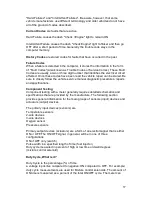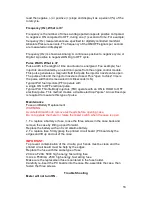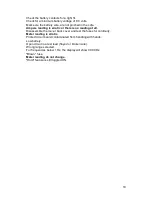
17
"Hard Failures" and "Intermittent Failures". Be aware, however, that some
vehicle manufacturers use different terminology and older vehicles do not have
all of the ground of codes described.
Current Codes
are faults that are active.
Hard Failure causes the dash "Check / Engine" light to remain ON.
Intermittent Failure causes the dash "Check Engine" light to flicker and then go
OFF after a short period of time. Generally the trouble code stays in the
computer memory.
History Codes
are stored codes for faults that have occurred in the past.
Failure Codes
When a failure is detected b the computer, it stores the information in the form
of "Fault Codes" (also known as Trouble Codes or Service Codes). These Fault
Codes are usually a two or three digit number that identifies the electrical circuit
effected. Once these codes have been read the vehicle repair can be stared. Be
sure to closely follow the vehicle service manual diagnostic precedures, repairs
and specifications.
Component Testing
Component testing with a meter generally requires detailed schematics and
specifications that are provided by the manufacture. The following section
provides general information for the main groups of sensors (input) devices and
actuators (output) devices.
The primary input devices (sensors) are:
Temperature sensors
2-wire devices
3-wire devices
Oxygen sensor
Pressure sensors
Primary output devices (actuators) are a form of an electromagnet that is either
ON or OFF.The ON/OFF signal, in general, will be in one of three
configurations:
ON of OFF only (switch)
Pulse width in a specified length of time (fuel injector)
Duty cycle measured in percent of high or low time or dwell degrees
(mixture control solenoid)
Duty Cycle, What is it?
Duty Cycle is the percentage (%) of time
a voltage is positive campared to negative: ON compared to OFF. For example;
duty cycle measurements are used for Mixture control solenoids. The amount of
ON time is measured as a percent of the total ON/OFF cycle. The meter can



































